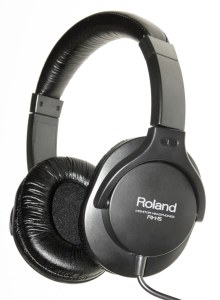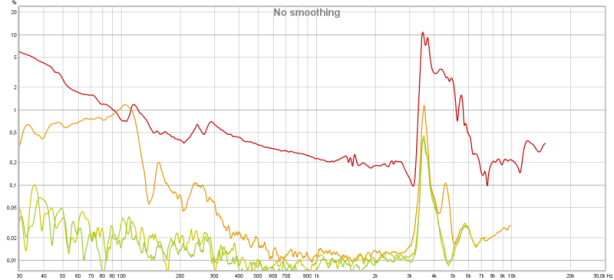RH-5
back to Roland
back to measurements
home
published: Mar-25-2020
NO SMOOTHING is applied to the shown plots. Most measurement sites have some smoothing applied which ‘irons flat’ sharp peaks and ‘wiggles’. I do not use smoothing because some info about sound quality is lost when plots are smoothed.
Aside from a small correction of the microphone itself also some correction in the lowest frequencies is applied to the plots to compensate for the perceived loss of bass when using headphones. This is described HERE in more detail.
A ‘horizontal‘ frequency response curve on the shown frequency response plots on this website thus indicates a perceived ‘flat’ tonal signature.
ALL measurements are made with a good SEAL on a flatbed measurement rig.
The shape of your head, bone structure, pad size, pad ‘softness, (compliance), hair or no hair and or wearing glasses may (drastically) change the frequency response of some headphones, so… your personal experience may differ substantially from these plots.
Frequency response (tonal balance) is the most sound-determining aspect of headphones. A horizontal line shows audible neutral response in the plots on this website. Deviations in different severities at different frequency bands have an effect on the sound character.
The bigger the deviation the stronger the effect.
Below an aid to help determining the sound character of headphones with relation to the frequency response.

Roland RH-5
The Roland RH-5 is intended to be used with musical instruments monitoring purposes. It is the cheapest headphone in the Roland line and costs between €25 and €30.-.
The headphone has a plastic look and feel. It is quite lightweight (190 gram without the cable) The headband is firm-padded and pleather covered. The pads are made of very thin and soft pleather. The pads aren’t soft/compliant as the foam inside feels quite firm.
Because of this getting a good seal isn’t easily done.
Pads can be changed (fortunately)
The clamping force is quite low but due to the light weight it doesn’t move on the head when moving around. Moving the headphone on the head causes a lot of noises.
The cups can be rotated over almost 360 degrees. Swivel is good. Height can be adjusted over 25mm and may not fit all heads.
Comfort is good due to the light weight but the ears do get warm after some time and the pads somewhat sticky.
Isolation is not very good. Certainly not for a sealed headphone.
The cable is long (3 meters) and has a 3.5mm TRS jack. A 6.3mm adapter is included. The cable is somewhat supple, feels decent and is somewhat microphonic
There is a 40mm driver with a 32Ω impedance. The efficiency is not very high (92dB @ 1mW). The driver can handle 1W so can take a beating when lying on the desk.
specifications:
Type: On-ear, closed
Usage: Home, Studio
Isolation: decent (closed headphone)
Driver type: dynamic
Pads: replaceable, pleather
Inner pad dimensions: Height:55mm, Width:35mm Depth:12mm
Collapsible: no
Headphone connector: fixed
Cable entry: left sided.
Cable: 3m terminated in a 3.5mm TRS connector
Driver size: ø 40mm
Nom. power rating: 1W
Max. voltage: 5.6V
Max. current: 180mA
Max. S.P.L.: 122dB
Impedance: 32Ω
Efficiency: 92dB @ 1mW
Sensitivity: 107dB @ 1V
Weight: 240g. (incl. cord)
Colour: black
Clamping force: low
Accessories: 6.3mm adapter
Sound description:
The character is warm with a deep and somewhat exaggerated bass.
Bass quality and mids is decent. The area where it lacks is ‘clarity/presence’.
Bass is ‘wooly’ and the mids are a bit compressed and somewhat ‘muffled’ sounding.
There is a strange ‘disconnection’ between the mids and the treble. A tonality this is a bit ‘off’. The treble itself is at a good level and even though somewhat on the coarse side the quality isn’t poor. There is no sibilance or harshness. Single instruments and recordings with just a guitar and singer sound decent. This is what the RH-5 is intended for.
With more complex music the RH-5 cannot be called Hi-Fi and becomes boomy, muffled and compressed sounding.
measurements:
Below the frequency response of the Roland RH-5 (Left, Right) The channel imbalance was immediatly obvious whn listening to these headphones (before they were measured) Bass was completely ‘drawn’ to the left.
The channel imbalance was immediatly obvious whn listening to these headphones (before they were measured) Bass was completely ‘drawn’ to the left.
Measured it a number of times to be sure including pressing the headphones against the test fixture (clamping force is low).
So I decided to open them up and to see if the left side had something weird going on inside. Nothing out of the ordinary was found. Also the right channel looked O.K.
Picture below is of the left channel where the cable entry is.

After re-assembly it measured differently. Still L-R differences but smaller. The Right channel had more bass so may not have been assembled properly ?
Below the frequency response (Left, Right) after re-assembly.
Even though the stereo image was still slightly pulling towards the left it was improved.
Bass is emphasized and a bit ‘wooly’. The mids were good in tonality but had a ‘cuppy’ sound and lacked clarity. I reckon the steep and deep dip (was present with different pads I tried as well so a driver issue) is responsible for the lack of ‘clarity’.
The treble was a bit ‘disattached’ from the rest of the sound and actually of good quality.
No sibilance and well extended but not very detailed. No audible roll-off.
As a comparison a 10x more expensive and well regarded (flat as in tonally neutral) headphone. HD600 vs. RH-5 (this comparison was requested)
No comments on this other than the HD600 is almost 8x more expensive (and open)
Seal
Seal is often an issue with closed-back headphones. Breaking the seal (improper fit on the head) usually means a loss of (sub)bass. Below the effect of different levels of seal breach are shown (Right channel) .
Perfect seal, Seal broken with a thin arm (temple) pair of glasses, Seal broken with a thick arm (temple) pair of glasses, seal broken using a 6.3mm TRS plug. Getting a good seal is important with this headphone. When there is just a slight seal breach the bass levels go from boosted to ‘normal’. When it is breached a bit more the bass audible drops.
Getting a good seal is important with this headphone. When there is just a slight seal breach the bass levels go from boosted to ‘normal’. When it is breached a bit more the bass audible drops.
Because seal is important one would expect soft and compliant pads and or some clamping force ensuring good bass response.
Alas, the bads are rather thin, pretty stiff (non compliant to headshape) and the clamping force is low. All ingredients for easily getting a poor seal.
Indeed it takes some careful positioning to get an ‘even’ and decent bass response.
output resistance / damping-factor
As this is a dynamic headphone the frequency response might be amplifier output resistance dependent when certain higher output resistance amplifiers are used.
To test this the headphone is measured via a low impedance amplifier (0.2Ω) and a high impedance amplifier (120Ω). On a higher output resistance amplifier the output level will be 13.3dB lower. To compensate for this the amplifier is cranked up to the same level (at 1kHz) as the low impedance amplifier. This way the plots are overlay-ed and it is easy to see how the tonal balance changes. 
The good news here is that a higher output resistance only results in a lower output level. The impedance is as good as ruler flat and the tonal balance is not affected by the output resistance at all. So even when the output resistance is on the higher side (sometimes the case with instruments) the tonal balance remains the same.
Below the distortion plot of the Right channel.
plot above is in a dB scale, below the same measurement but in a percentage scale.
This is not measuring particularly well. The distortion of the lower frequencies is not uncommon for smaller (40mm) drivers. The distortion at 4.8kHz (see dB scale plot above the percent scale plot) is rather high. The percentage plot above is a bit misleading when showing 10%. The dip between 3kHz and 4kHz and normalizing that to 100% makes the distortion appear higher as it is. Around 5kHz the distortion is around 2kHz which is audible.
Below the CSD of the RH-5 (Right and Left channel superimposed) The CSD shows resonances between 3kHz and 6kHz. The peak near 500Hz is causing the ‘cuppy’ sound which ‘muddies’ the sound a bit. The sound is not very dynamic and clear.
The CSD shows resonances between 3kHz and 6kHz. The peak near 500Hz is causing the ‘cuppy’ sound which ‘muddies’ the sound a bit. The sound is not very dynamic and clear.
The spectrum plot below (left channel) also shows some ringing issues at a lower amplitude. At 1.5kHz and 2.7kHz and 5.8kHz there are some resonances visible.
Below the impulse response of the left and right driver.
This doesn’t look that bad. It shows the treble is at a good level. There is a slight emphasis in the treble and lows extension is quite good given the horizontal part stays horizontal for quite some time. The channel difference also is visible here where the Left channel has more lows than the Right channel. Bass extension is decent but no deep rumbles.
conclusion
Positives:
- weight
- price
- cable length (3 meter) handy for instruments
- sounds good/decent with just 1 or 2 instruments playing
- treble quality decent
- Low clamping force
- Can be worn for long time period
Not so positive:
- cable length (3 meter) not handy when used with a phone
- lacks clarity/presence, sounds muddy/cuppy with complex music
- bass is emphasized and a bit ‘muddy’
- Pad and headband pleather quality, prone to flaking.
- pads become sweaty/warm
- getting a good seal is not guaranteed
- low isolation of abient sounds despite being closed
- channel imbalance
- sound quality with music
For its price this headphone is good for monitoring of musical instruments (what it is intended for) but isn’t suited for enjoying music.
In this price class one would better have a close look at Superlux headphones.
